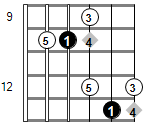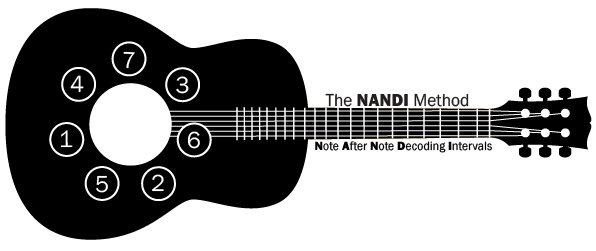Major Triads
A triad is a simple chord, comprised of the root, the third, and the fifth.
An E Major triad in root position would be E-G#-B.
What does it mean to invert a chord? An inversion is when you play all the notes in a triad but don’t play the root note in the bass. A first inversion puts the third in the bass, while a second inversion puts the fifth in the bass.
So an E Major triad in first inversion would be spelled G#-B-E, and second inversion would be spelled B-E-G#.
With the NANDI method we can use fourth intervals to decode triads. Take a look at the fret diagrams below.
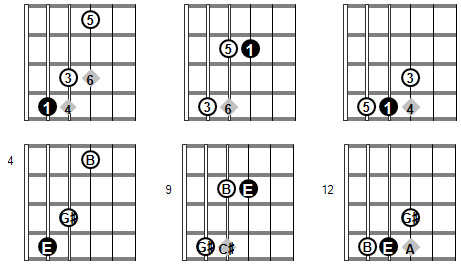
![]()
Let’s start with our root position triad with E on the 7th fret of the A string. We know that the same fret one string up is a fourth, so we simply move one half-step down and we’re at our major third. One fourth up from our third brings us to the sixth, so we drop one whole step to the fifth. And that gives us an E major triad in root position!
For a first inversion we would start on G# at the 11th fret of the A string. Just like the root position, we know that one string up from the third is the sixth, so if we drop that one whole step we get the fifth. And from the fifth we go up one string and we’re back at the root, and we’re already done with our first inversion.
And finally our second inversion. I think you’re getting the hang of this. Starting on the fifth, we move one string up which brings us to the root. Then from the root we move one string up, which is our fourth, so we move down a half-step to our major third. That’s a second inversion.
These shapes are universal for all major chords, just keep in mind the half-step adjustment you will have to make if your triad crosses onto the B string!
Watch the video below to learn how to identify the chord tones in a basic major triad:
How to Find Root Position And Inversions In CAGED Shapes
When it comes to understanding chords, major triads are the foundation point.
Understanding the inversions of major and minor triads as you move up the fretboard is also incredibly important. The use of triad inversions helps us to
- Smooth out the motion as we move from chord to chord
- Harmonize melodies in unique ways
- Smooth out the motion of our “bass lines”
Plus, the use of inversions allows us guitar players to play virtually any chord we can think of almost anywhere on the neck. Inversions are awesome.
Let’s dive a little deeper now to see how we can plot our major triads and inversions.
The first thing that we must do before anything else is plot our major triad in root position.
For the sake of ease, we will be using the C major triad, which is C-E-G, though we can use the same basic principle for all major triads as well.
C Shape – C Major Triad Inversions
When we plot our major triad in root position, we want to find the third (3) and the fifth (5) without moving more than one fret above or below the two root locations.
Here is a chart that we often use to help us locate the chord tones 3 and 5. This chart is the “Fourths Pattern”
![]()
A fourth up from the 1 is the 4. We can move one fret below that 4 to get to our 3. To find the 5 on the next string, we can refer back to our chart to see that a fourth up from the 3 is 6. We can use that 6 as a reference to locate the 5 two frets down.
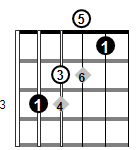
Now let’s move on and find the first inversion major triad where the 3 is the lowest note in the chord, followed by the 5 and the 1. It should look like this:
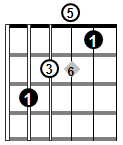
Starting from our 3, we can move a fourth to our 6. Two frets down from that 6 is our 5. Refer back to the fourth pattern chart once again and you will see that a fourth from 5 is 1.
Remember, a fourth from any note will always be on the same fret on the next string over. The only exception is when we are moving from the G to the B string, in which case the fourth will be one fret up.
Now let’s move on to our second inversion major triad, where our 5 is in the bass, followed by the 1 and the 3. It should look something like this:
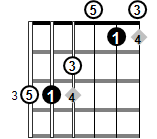
A fifth will always be on the same fret as the root and one string down. The only exception here is when we move from the B to the G string, in which case it will be one fret down from the root. We have already identified how to use a fourth from the 1 to locate the 3, as well as how we can use a fourth from 3, which is 6, to locate the 5.
As you can see, there are two major triads in second inversion when using the C shape.
Now that we have the bulk of the theory out of the way, let’s move on to the other shapes, where we will be using the same basic principles to find our triads.
A Shape: C Major Triad
When we are in the A Shape, it is not possible to plot a root position chord from the lower root, which is why we plot it from the higher root instead.

A fourth from the root on the G string will be one fret up on the B string. One fret down from that 4 is, of course, the 3. If we move a fourth up from 3 we get 6. Two frets down from that 6 is the 5.
If you are thinking,
“Hey wait a minute! I’m seeing a pattern here!”
You are absolutely right. Let’s continue…
Plotting a first inversion triad in the A shape is not possible, as you cannot complete the triad from the lower root while staying within the shape. This is because our goal here is not to go more than a fret below the lowest root in the shape. Unfortunately, we do not have enough strings from the top root.
Since we cannot plot a first inversion triad in this shape, let’s move on to the second inversion triad. A 5 can be found to the left of the lower root. We can then move up a fourth to get the 1. From there, we can move one more fourth down and one fret down to find the 3.
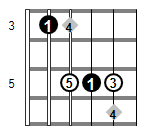
G Shape: C Major Triad
When in the G shape, the root position chord can be built on the lowest root. We can use the fourth from the root on the low E string to find the 3. A fourth from that 3 is 6, and two frets down from that 6 is 5.
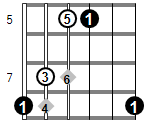
You can look at the same diagram above to find the 3-5-1 or first inversion.
The second inversion triad can be seen below as well
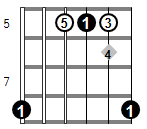
E Shape: C Major Triad
Moving on to the E shape, you guys should already have a pretty good idea of how this works.
From the E shape, as you can see in diagram, the root position triad from the top root moves 1-4-3-6-5.
For the first inversion triad, we can move 3-6-5-1
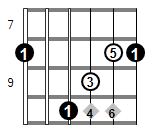
For the second inversion triad, we can move 5-1-4-3
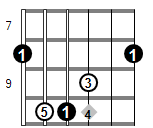
D Shape: C Major Triad
The D shape is where things start to get a little bit interesting.
Remember, the idea here is that we do not want to move more than one fret below the lowest root in the shape. In this case, we do not have enough strings from the top root to find the root position chord.
For the first inversion D shape chord, you have a similar situation. However, there is another option here that we can take advantage of.
We have the ability to use a major second two strings down from the root as a helpful reference to locate the 3, which can be found two frets up.
We find that string relationships are very helpful to use as reference points when locating chord tones. That is our main focus with the NANDI Method. In this case, the major second that is between D and E can be used as a reference point to locate the 3, which can be found on the lower string.
Now moving on, a fourth from 3 is 6. We can use the 6 as a reference, like we’ve been doing, to find the 5 two frets down. Lastly, a fourth from 5 is, of course, the 1.
The second inversion triad for the D shape is 5-1-4-3 from the lower root. It is also the same from the higher root.
